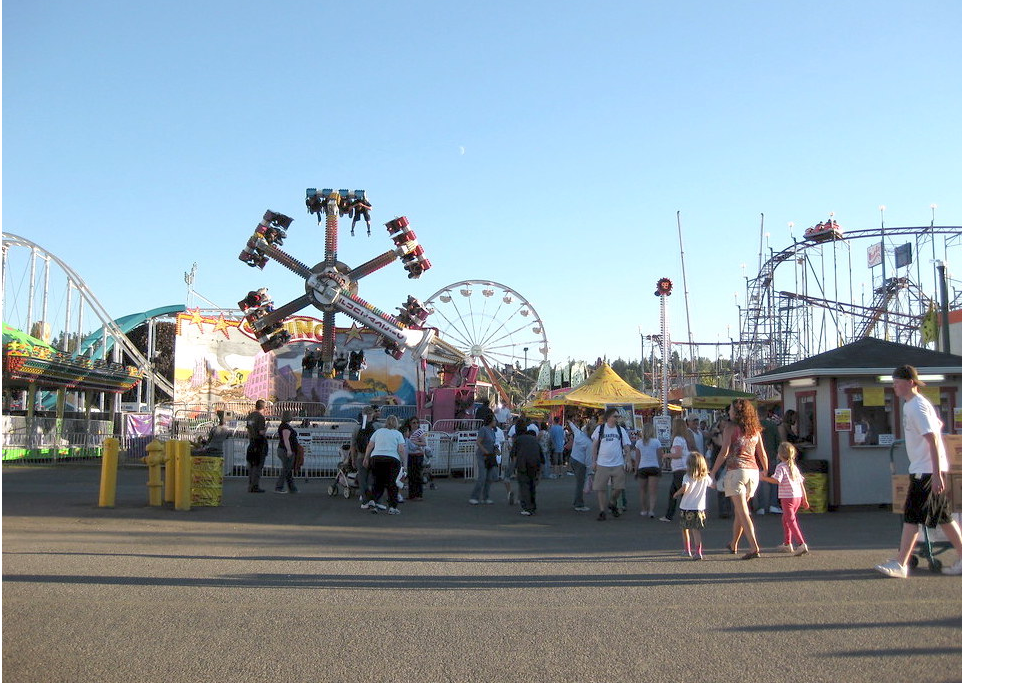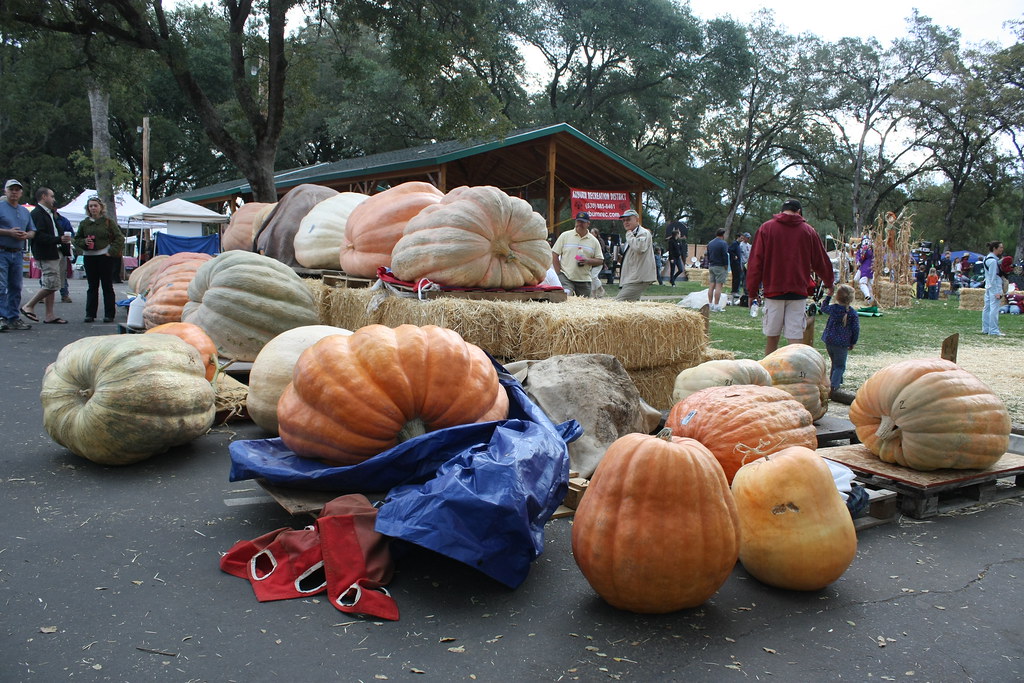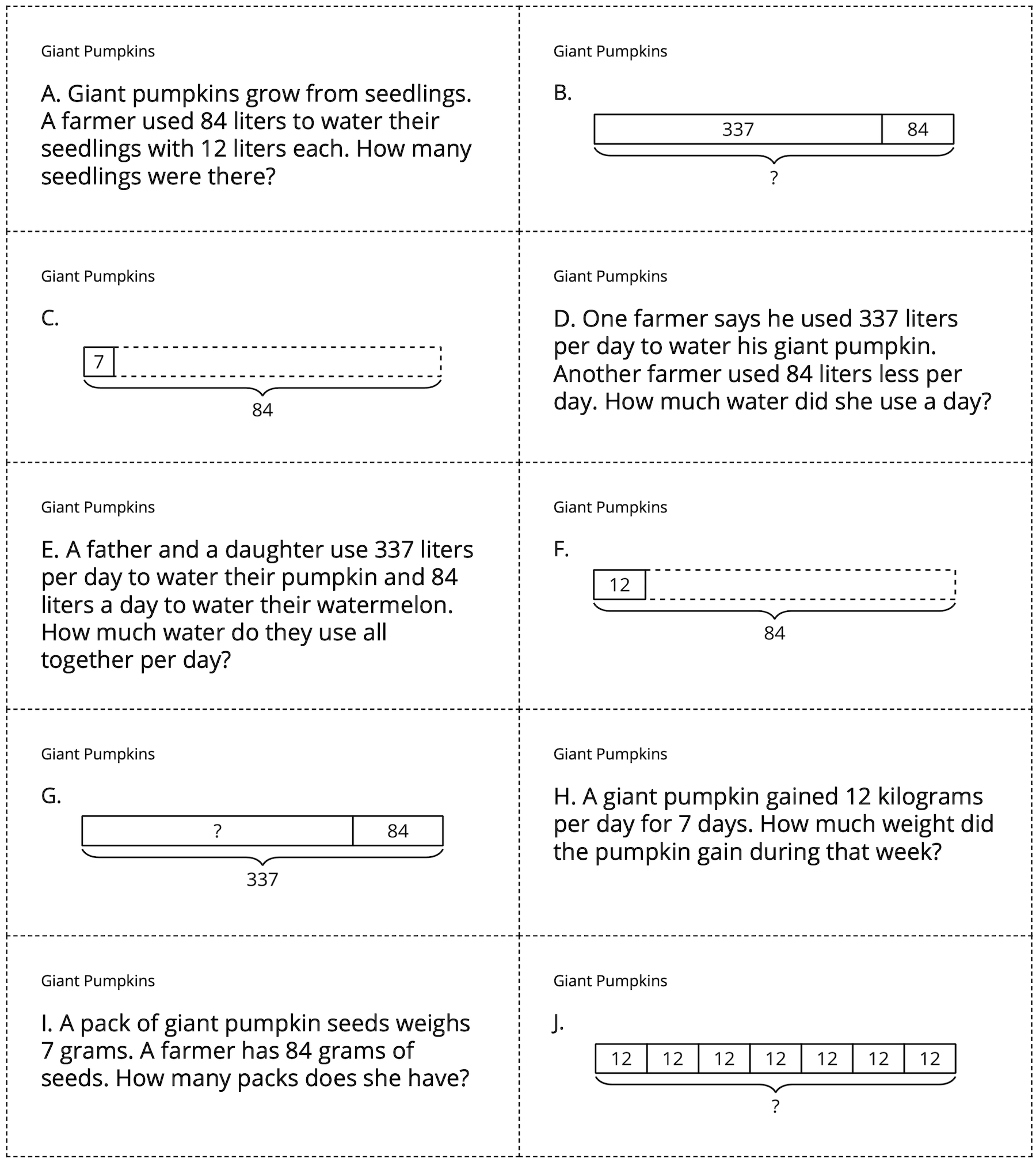Lesson 12
Ways to Represent Measurement Situations
Warm-up: Notice and Wonder: The Fair (10 minutes)
Narrative
The purpose of this warm-up is to elicit the idea that there are many mathematical contexts at a state or county fair, and to familiarize students with some possible situations before they solve problems in upcoming activities.
Launch
- Groups of 2
- Display the images.
- “What do you notice? What do you wonder?”
- 1 minute: quiet think time
Activity
- “Discuss your thinking with your partner.”
- 1 minute: partner discussion
- Share and record responses.
Student Facing
What do you notice? What do you wonder?



Student Response
For access, consult one of our IM Certified Partners.
Activity Synthesis
- “In the next few lessons, we are going to solve problems that might come up at a fair. What are some activities that could be at a fair?” (carnival rides and games, food, animals in barns, concerts with music, shows)
- “Where might you see math at the fair?” (We needed money to buy things or buy tickets for rides. They weighed things like vegetables and animals.)
Activity 1: Giant Pumpkin Event (20 minutes)
Narrative
The purpose of this activity is for students to solve problems involving weights that are given in the same units. Students begin by generating mathematical questions about an image of two giant pumpkins. Then, weights are given for each pumpkin and students narrow down the questions that could be answered with this information. Students then solve one of the problems generated by the class. Students can all solve the same problem or each group could solve a different problem. As students are generating questions that can be answered, decide which option makes the most sense for your class.
This activity uses MLR5 Co-craft Questions. Advances: Writing, Reading, Representing.
Required Materials
Materials to Gather
Launch
- Groups of 2
MLR5 Co-Craft Questions
- Display the image.
- “Write a list of mathematical questions that could be asked about this image.”
- 1 minute: independent work time
- 1–2 minutes: partner discussion
- If students don’t generate questions that involve weight or liquid volume, consider asking: “What are some mathematical questions we could ask that involve weight (or liquid volume)?”
- Invite several students to share one question with the class. Record responses.
Activity
- “At the giant pumpkin event at the fair, they weigh the pumpkins to see which is the heaviest. The heaviest pumpkin wins. The smaller pumpkin weighs 276 kg. The larger pumpkin weighs 347 kg.”
- Record weights for all to see.
- “Now that we know the weight of each pumpkin, what mathematical questions could we answer?” (How much more does the heavier pumpkin weigh? How much less does the lighter pumpkin weigh? How much do the pumpkins weigh together?)
- 2 minutes: partner discussion
- Share and record responses.
- Give each group tools for creating a visual display.
- Have each group create a poster for one of the problems the class came up with. Decide whether the class will solve the same problem or if there is enough variety to have groups solve different problems.
- 5 minutes: partner work time
Student Facing

- Write a list of mathematical questions that could be asked about this image.
- Work with your partner to solve the problem you were given by your teacher and show your thinking on a poster. Be sure to write down on your poster the problem you are solving.
Student Response
For access, consult one of our IM Certified Partners.
Activity Synthesis
- Display student posters around the room. If students solved different problems, group them by problem solved.
- 5 minutes: gallery walk
- If students solved the same problem, ask:
- “What is the same and what is different about how this problem was represented on the posters?”
- If students solve different problems, ask:
- “What connections do you notice about how these problems are represented?”
Activity 2: Card Sort: Giant Pumpkins (15 minutes)
Narrative
The purpose of this activity is for students to make sense of representations of situations involving weights and liquid volumes. Students are reminded that tape diagrams can be used to represent relationships between quantities in different types of problems.
As students analyze descriptions of situations and make connections across representations, they practice looking for and making use of structure (MP7). As they relate the numbers and relationships in situations to those in diagrams, they reason quantitatively and abstractly (MP2).
Advances: Speaking, Representing
Supports accessibility for: Organization, Social-Emotional Functioning
Required Materials
Materials to Copy
- Card Sort: Giant Pumpkins
Required Preparation
- Create a set of cards from the blackline master for each group of 2.
Launch
- Groups of 2
-
Give one set of pre-cut cards to each group of students.
Activity
- “This set of cards includes situations and diagrams. Work with your partner to match each situation to a diagram that represents it. Be prepared to explain your matches.”
- 8 minutes: partner work time
Student Facing
Your teacher will give you a set of cards with descriptions and diagrams.
Match each description with a diagram that represents the same situation.

Student Response
For access, consult one of our IM Certified Partners.
Activity Synthesis
- Display diagram C and situation I.
- “How do you know this diagram matches this situation?” (The 7 in the diagram represents each pack of seeds weighing 7 grams. The 84 shows that all the seed packs weigh 84 grams. The dotted lines in the diagram shows that we don’t know how many seed packs there are.)
- “What equations could we write to match this diagram?” (\({?}\times7=84\) or \(84\div7={?}\))
- Discuss how students know that diagram B and situation E are a match and how the situation could be represented with equations.
- Attend to the language that students use in their explanations, giving them opportunities to describe the situations and diagrams more precisely.
Lesson Synthesis
Lesson Synthesis
“Today we solved problems about weight and liquid volume related to giant pumpkins. What helps you make sense of such problems?” (It helps to think about what is happening in the situation and relate the weights or liquid volumes to what I know, like how heavy 1 kilogram is or how much 1 liter is.)
“What representations do you like to use when solving problems involving weight or liquid volume?” (When I am adding and subtracting, I like to use a number line, tape diagram, or just equations. When I am multiplying or dividing, I draw equal groups or base-ten block drawings.)
Cool-down: Which Diagram Matches? (5 minutes)
Cool-Down
For access, consult one of our IM Certified Partners.